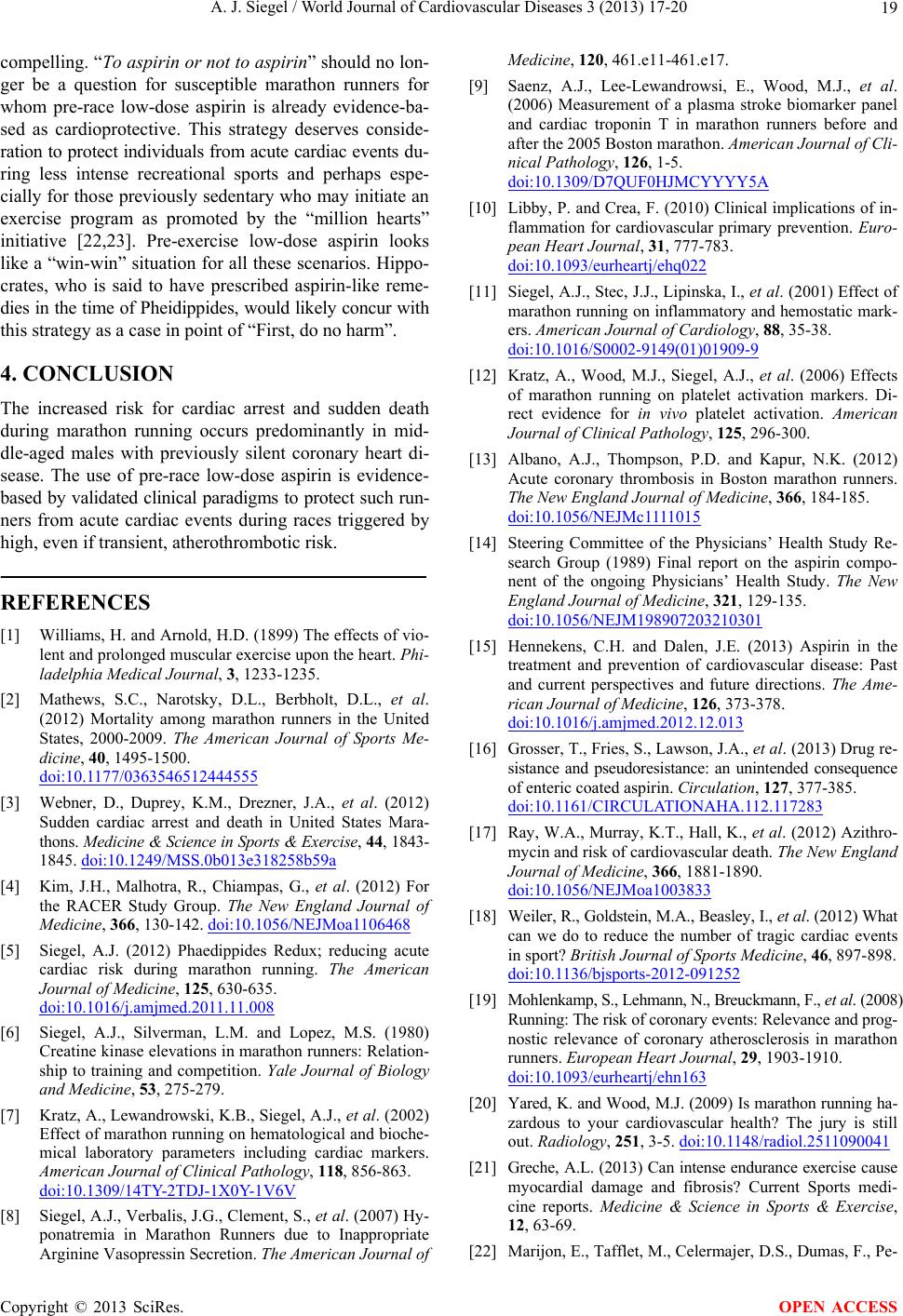
A. J. Siegel / World Journal of Cardiovascular Diseases 3 (2013) 17-20 19
compelling. “To aspirin or not to aspirin” should no lon-
ger be a question for susceptible marathon runners for
whom pre-race low-dose aspirin is already evidence-ba-
sed as cardioprotective. This strategy deserves conside-
ration to protect individuals from acute cardiac events du-
ring less intense recreational sports and perhaps espe-
cially for those previously seden tary who may initiate an
exercise program as promoted by the “million hearts”
initiative [22,23]. Pre-exercise low-dose aspirin looks
like a “win-win” situation for all these scenarios. Hippo-
crates, who is said to have prescribed aspirin-like reme-
dies in the time of Pheidippides, would likely concur with
this strategy as a case in point of “First, do no harm”.
4. CONCLUSION
The increased risk for cardiac arrest and sudden death
during marathon running occurs predominantly in mid-
dle-aged males with previously silent coronary heart di-
sease. The use of pre-race low-dose aspirin is evidence-
based by validated clinical paradigms to protect such run-
ners from acute cardiac events during races triggered by
high, even if transient, atherothrombotic risk.
REFERENCES
[1] Williams, H. and Arnold, H.D. (1899) The effects of vio-
lent and prolonged muscular exercise upon the heart. Phi-
ladelphia Medical Journal, 3, 1233-1235.
[2] Mathews, S.C., Narotsky, D.L., Berbholt, D.L., et al.
(2012) Mortality among marathon runners in the United
States, 2000-2009. The American Journal of Sports Me-
dicine, 40, 1495-1500.
doi:10.1177/0363546512444555
[3] Webner, D., Duprey, K.M., Drezner, J.A., et al. (2012)
Sudden cardiac arrest and death in United States Mara-
thons. Medicine & Science in Sports & Exercise, 44, 1843-
1845. doi:10.1249/MSS.0b013e318258b59a
[4] Kim, J.H., Malhotra, R., Chiampas, G., et al. (2012) For
the RACER Study Group. The New England Journal of
Medicine, 366, 130-142. doi:10.1056/NEJMoa1106468
[5] Siegel, A.J. (2012) Phaedippides Redux; reducing acute
cardiac risk during marathon running. The American
Journal of Medicine, 125, 630-635.
doi:10.1016/j.amjmed.2011.11.008
[6] Siegel, A.J., Silverman, L.M. and Lopez, M.S. (1980)
Creatine kinase elevations in marathon runners: Relation-
ship to training and competition. Yale Journal of Biology
and Medicine, 53, 275-279.
[7] Kratz, A., Lewandrowski, K.B., Siegel, A.J., et al. (2002)
Effect of marathon running on hematological and bioche-
mical laboratory parameters including cardiac markers.
American Journal of Clinical Pathology, 118, 856-863.
doi:10.1309/14TY-2TDJ-1X0Y-1V6V
[8] Siegel, A.J., Verbalis, J.G., Clement, S., et al. (2007) Hy-
ponatremia in Marathon Runners due to Inappropriate
Arginine Vasopressin Secretion. The American Journal of
Medicine, 120, 461.e11-461.e17.
[9] Saenz, A.J., Lee-Lewandrowsi, E., Wood, M.J., et al.
(2006) Measurement of a plasma stroke biomarker panel
and cardiac troponin T in marathon runners before and
after the 2005 Boston marathon. American Journal of Cli-
nical Pathology, 126, 1-5.
doi:10.1309/D7QUF0HJMCYYYY5A
[10] Libby, P. and Crea, F. (2010) Clinical implications of in-
flammation for cardiovascular primary prevention. Euro-
pean Heart Journal, 31, 777-783.
doi:10.1093/eurheartj/ehq022
[11] Siegel, A.J., St ec, J.J., Lipinska, I., et al . (2001) Effect of
marathon running on inflammatory and hemostatic mark-
ers. American Journal of Cardiology, 88, 35-38.
doi:10.1016/S0002-9149(01)01909-9
[12] Kratz, A., Wood, M.J., Siegel, A.J., et al. (2006) Effects
of marathon running on platelet activation markers. Di-
rect evidence for in vivo platelet activation. American
Journal of Clinical Pathology, 125, 296-300.
[13] Albano, A.J., Thompson, P.D. and Kapur, N.K. (2012)
Acute coronary thrombosis in Boston marathon runners.
The New England Journal of Medicine, 366, 184-185.
doi:10.1056/NEJMc1111015
[14] Steering Committee of the Physicians’ Health Study Re-
search Group (1989) Final report on the aspirin compo-
nent of the ongoing Physicians’ Health Study. The New
England Journal of Medicine, 321, 129-135.
doi:10.1056/NEJM198907203210301
[15] Hennekens, C.H. and Dalen, J.E. (2013) Aspirin in the
treatment and prevention of cardiovascular disease: Past
and current perspectives and future directions. The Ame-
rican Journal of Medicine, 126, 373-378.
doi:10.1016/j.amjmed.2012.12.013
[16] Grosser, T., Fries, S., Lawson, J.A., et al. (2013) Drug re-
sistance and pseudoresistance: an unintended consequence
of enteric coated aspirin. Circulation, 127, 377-385.
doi:10.1161/CIRCULATIONAHA.112.117283
[17] Ray, W.A., Murray , K.T., Hall, K., et al. (2012) Azithro-
mycin and risk of cardiovascular death. The New England
Journal of Medicine, 366, 1881-1890.
doi:10.1056/NEJMoa1003833
[18] Weiler, R., Goldstein, M.A., Beasley, I., et al. (2012) What
can we do to reduce the number of tragic cardiac events
in sport? British Journal of Sports Medicine, 46, 89 7 - 89 8 .
doi:10.1136/bjsports-2012-091252
[19] Mohlenkamp, S., Lehmann, N., Breuckmann, F., et al. (2008)
Running: The risk of coronary events: Relevance and prog-
nostic relevance of coronary atherosclerosis in marathon
runners. European Heart Journal, 29, 1903-1910.
doi:10.1093/eurheartj/ehn163
[20] Yared, K. and Wood, M.J. (2009) Is marathon running ha-
zardous to your cardiovascular health? The jury is still
out. Radiology, 251, 3-5. doi:10.1148/radiol.2511090041
[21] Greche, A.L. (2013) Can intense endurance exercise cause
myocardial damage and fibrosis? Current Sports medi-
cine reports. Medicine & Science in Sports & Exercise,
12, 63-69.
[22] Marijon, E., Tafflet, M., Celermajer, D.S., Dumas, F., Pe-
Copyright © 2013 SciRes. OPEN ACCESS